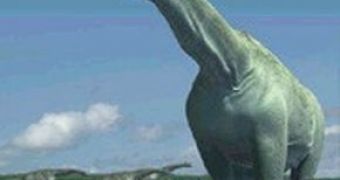Spanish fossil hunters from the Fundaci?n Conjunto Paleontol?gico de Teruel-Din?polis in Teruel (Northeastern Spain) have discovered Europe's biggest dinosaur ever found.
The researchers uncovered parts of the legs, skull, spine, and ribs in Riodeva.
The new species, named Turiasaurus riodevensis, was estimated to have reached 120 feet (37 meters) in length and 48 tons in weight (as much as seven adult male elephants) and lived 150 million years ago, during the Jurassic period (the middle age of dinosaurs).
This is probably the only member of a distinct group of sauropods (the group of long-necked plant-eaters with huge Tails that were the largest animals ever to have walked Earth) so far found in Europe.
Well-known sauropods, from North America, include Apatosaurus (once called Brontosaurus), Brachiosaurus, and Diplodocus. The world's biggest recorded dinosaur is a sauropod, Argentinosaurus, from South American, estimated to be 100 tons heavy and 38 m long. Turiasaurus was comparable in size to sauropod species from North and South America.
The 1.79m long humerus (upper arm bone) is one of the largest ever recorded, almost as big as that of Argentinosaurus, while one of its claws is comparable with an American football or rugby ball. "Argentinosaurus has bigger vertebrae than Turiasaurus, but the limb bones are only slightly bigger than Turiasaurus," said lead researcher Rafael Royo-Torres. "Turiasaurus indeed claims the title of dinosaur heavyweight champion of Europe," concedes paleobiologist David Martill from the University of Portsmouth, England.
Europe's former biggest dinosaur was a brachiosaur sauropod, measured at least 65 feet (20 meters) in length and weighed up to 40 tons, found on Southern England. "Turiasaurus belongs to a new branch of basal sauropods that had more primitive limb and bone structures than other giant species," the Spanish research team says. These features include "primitive vertebrae with solid bone inside," Royo-Torres said, "while [brachiosaurs] had spongy bone."
"Turiasaurus shows that these sauropods originated in Europe 160 million years ago and that at least one of these more primitive sauropods achieved gigantic size independently of those found in other continents."
The teeth of Turiasaurus are similar to those found in France, Portugal, and England, suggesting this type of dinosaur roamed other parts of Europe during the Jurassic period. "I don't think there was any problem getting from Spain to England in those days," said Martill. "We're finding the dinosaurs that are turning up in Spain are the same species of dinosaurs that we're turning up here in England."
The discovery site also contains teeth from theropods (carnivorous dinosaurs), bones of Stegosaurus (plated dinosaurs), and fragments from fish and turtles.

 14 DAY TRIAL //
14 DAY TRIAL //